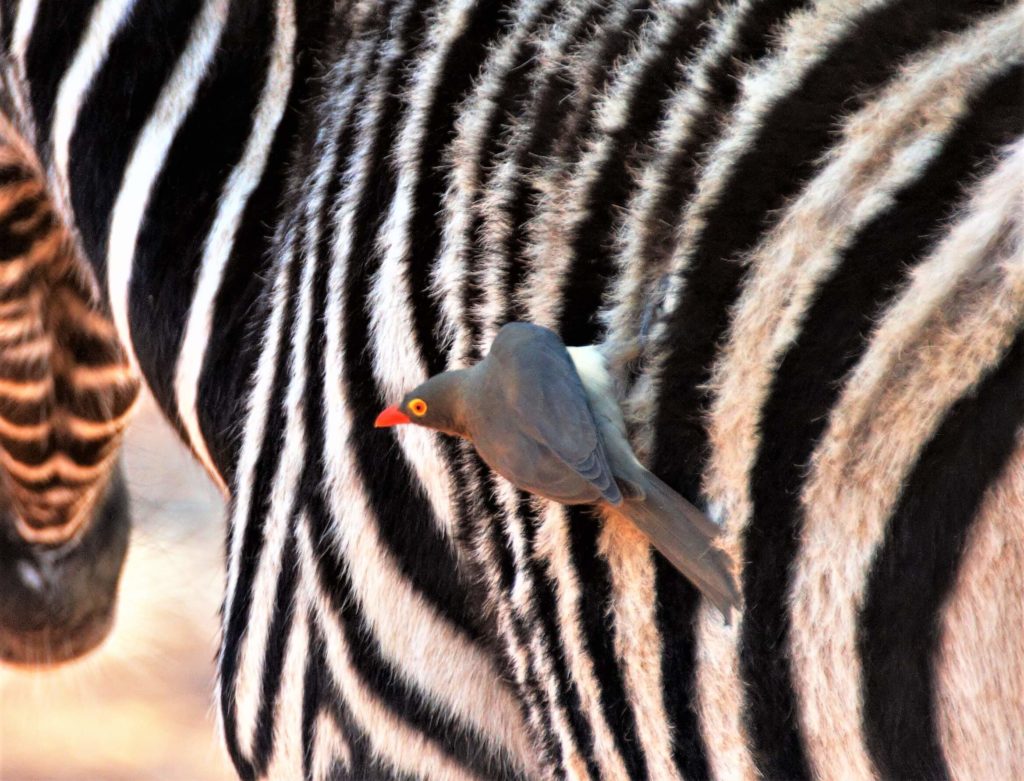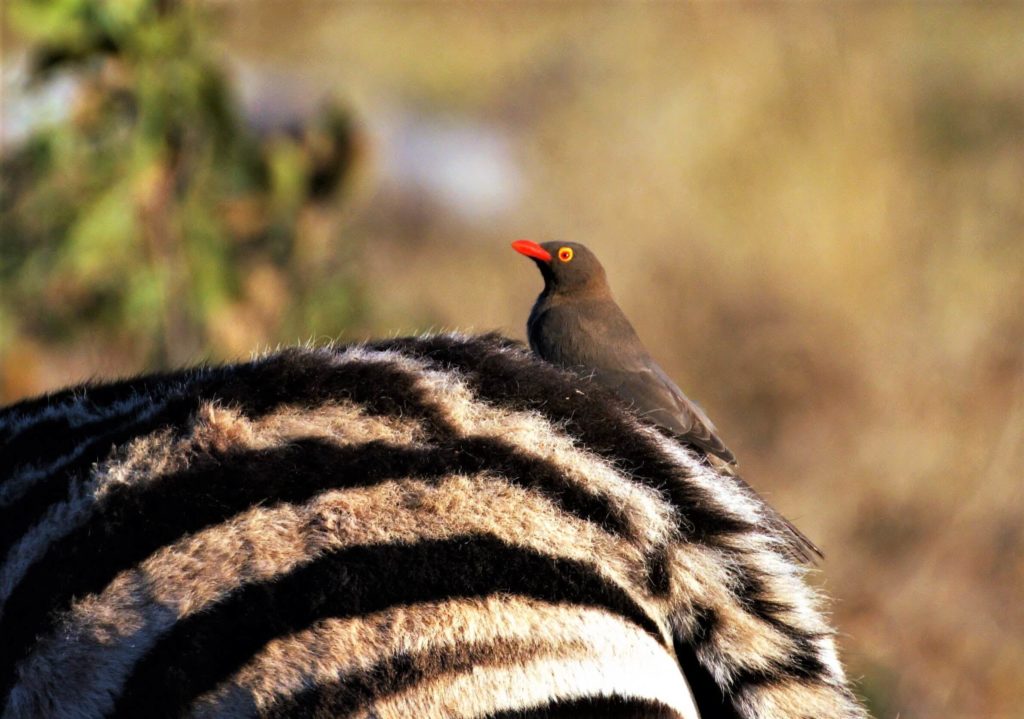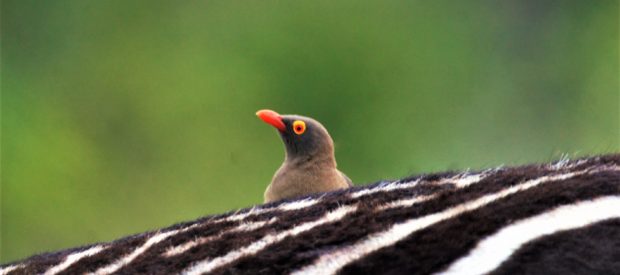Red-Billed Oxpecker – A Key Ecological Species
Buphagus erythrorhynchus
It is not often these days that you will head out on a game drive or outing in the bush without coming across the unique birds that are associated with several of the larger herbivores. Hopping around on the backs of buffalo, rhino or giraffe, these little brown birds with their distinct red bills and yellow ring around the eyes are an incredibly important species in the ecosystem. These are the red-billed oxpeckers.
Red-billed oxpeckers are recognised for taking part in symbiotic relationships with a variety of African ungulates. In the wild, oxpeckers generally prefer to forage for ticks (and other ectoparasites) on large herbivorous mammals such as buffalo, giraffe, white and black rhino, kudu and Burchells Zebra. Impala are highly preferred host species as well, although they are considered smaller ungulates and are not included in this generalisation.
These birds are well adapted to carrying about their daily feeding activities and have sharp claws and short legs, allowing them to cling easily onto the backs of wild herbivores. Not all species are tolerant of oxpeckers, such as elephant, waterbuck and warthog, who will sometimes reject them by head tossing or rolling in the dust. They spend most of their day on their hosts foraging for food, but will also sunbathe, dustbathe and bathe in water. They roost away from their hosts at night in trees often close to their nests, which are shallow holes in trees.
Oxpeckers feed primarily on the ticks on the host mammal but will also feed on mucous, blood from open wounds and will also hawk insects using their host as a perch. Feeding is dependent on their host species, but ‘scissoring’ is a technique that is commonly described. Ticks are plucked from the skin and the sharp edges of the bill are used in a ‘scissor’ fashion to remove other ectoparasites, mucous and blood by running the bill through the hair of their host. In the stomach of one bird in a study conducted on identifying food types, 1,665 ticks were found, in one stomach! Pretty incredible!
Ticks are attracted to their hosts by their body odour and breath, or the CO2 in their breath. Body odour is produced by the fatty, waxy substance known as sebum, which is secreted by the sebaceous tissue in the skin, usually in the hair follicle. Sebum helps lubricate the skin, keep it moist and forms a waterproof layer. Elephants lack this tissue in their skin and do not produce sebum, and therefore have fewer ticks.

Red-Billed Oxpecker Disappearance In The Waterberg
Once common in most wild, protected reserves and communal farming areas, oxpeckers have declined in numbers in most areas due to the impact of human activities. In the Waterberg region of the Limpopo Province of South Africa, where the Welgevonden Game Reserve lies, oxpecker numbers were drastically low until 2002 and, in many areas, extinct.
Between the 1800s and 1900s their numbers in the Waterberg saw a sharp decline due to big game hunting and the Rinderpest outbreak in this region. Host species were removed from the ecosystem through uncontrolled hunting. Livestock were treated with ectoparasiticides to remove ticks, resulting in ticks being toxic, and inadvertently killing the red-billed oxpeckers feeding on them. With the use of pesticides, tick loads were reduced, and this led to birds starving and moving out of areas to source enough food.
Since 1988, oxpeckers have been reintroduced into many reserves around Southern Africa. Kruger Park’s Dr Ian Whyte has been involved in the process of hundreds of birds being relocated from Kruger National Park to other reserves such as Marakele National Park, neighbouring Welgevonden Game Reserve. The Endangered Wildlife Trust (EWT) also recognised the decline in numbers of red-billed and yellow-billed oxpeckers in many protected and farmland areas in South Africa and in 2002 started Operation Oxpecker, a programme designed to captively breed these birds and return them to their natural habitats where they were now devoid. Their programme further aimed to inform and educate farming areas of the importance of the birds for tick control and the control of other ectoparasites in livestock and encourage more farmers to use ectoparasiticides that did not cause secondary poisoning in the control of ticks where dipping was still used, referred to as oxpecker-friendly.
In 2008, fifty red-billed oxpeckers were moved from the Skukuza area in the Kruger National Park to the Waterberg, to boost numbers in the Welgevonden Game Reserve and surrounding conservancy area. Rhino housed in the protection bomas near Skukuza were being irritated by the birds. These birds were keeping wounds on the animals open, not allowing them to heal, so the decision was made to remove the birds and relocate them at the same time, resulting in a beneficial joint operation with the EWT.
Anti-Poaching – Assisting Rhinos
Apart from controlling tick numbers, cleaning wounds and grooming larger herbivore mammals in the ecosystem, these birds are recognised in assisting their hosts in picking up on predators and potential poachers.
In the Annual General Meeting of the Waterberg Nature Conservancy, March 2012, Arnaud Le Roux (who heads EWT’s Operation Oxpecker), addressed the success of the reintroduction of oxpeckers to our area. The Swahili name for the red-billed oxpecker is “askari wa kifaru” and is translated to the rhino guard. It is widely understood that oxpeckers will act as a warning system to host species with regards to the presence of predators, particularly humans. This was tested by the EWT and the results were conclusive. Of a total of 61 approaches by a person to seven adult female black rhinoceros, the detection and detection distances were recorded where oxpeckers were both present and absent.
- Where oxpeckers were absent and no alarm call was given by them, the black rhinos were able to detect the person on 23% of the occasions (7 out of 31 approaches) at a distance of 27 meters
- Where oxpeckers were present, and alarm calls were given by them, the black rhinos were able to detect the person on 97% of the occasions (29 out of 31) at a distance of 66 meters
The detections were an immediate response to the oxpecker call. There was a significant positive relationship between the number of oxpeckers on the rhino and the detection distance.
The reintroduction of these birds into their natural areas could well have a positive impact on assisting rhinos to detect potential poachers and alert them to the presence of people.
These iconic bushveld birds are an integral part of a healthy functioning ecosystem and they continue to be a popular and common sight on the reserve. I have identified at least two nesting sites on Welgevonden and we are encouraged to see that they are thriving in this area again.

Words and images: Neil Davison.
References:
- Personal observations on Welgevonden Game Reserve and other Southern African Reserves
- Roberts Birds of Southern Africa 7th Edition; PAR Hockey, WRJ Dean & PG Ryan, John Voelcker Bird Book Fund, Jacana Publishers, 2005
- Beat about the Bush – Birds, Trevor Carnaby, Third Edition, Jacana, Johannesburg, 2018
Web References:

